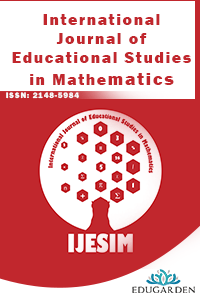Inverse Modeling Problems and Task Enrichment: Analysis of Two Experiences with Spanish Prospective Teachers
Inverse Modeling Problems and Task Enrichment: Analysis of Two Experiences with Spanish Prospective Teachers
Problem solving and problem posing are both important topics in mathematics education. Since in many branches of science and technology, typical problems are posed in an inverse form, we will focus on inverse problems that require modeling skills in order to be solved, i.e., the so-called inverse modeling problems. In this article, we will analyze them from the view point of their potential for task enrichment. For this purpose, a research project was carried out, by using inverse modeling problems to develop prospective teacher`s task enrichment skills. The results of this experience, that took place in 2017, showed that only few participants were very creative, whereas many others posed trivial problems or simply imitated examples previously analyzed. After that, a new research essay was implemented during the first months of 2019, with the aim of avoiding – or at least attenuating – those difficulties observed in the previous field work. The new results showed some few similarities and very interesting differences, when compared with the other experience. In this article, we comment our findings and some conclusions are reported.
___
- Blum, W. (2002). ICMI Study 14: applications and modelling in mathematics education – discussion document. Educational Studies in Mathematics, 51 (1-2), 149-171.
- Brown, S. I. & Walter, M. I. (2005). The art of problem posing. 3rd ed. Hove, UK: Psychology Press.
- Brown S. I. & Walter, M. I. (2014). Problem posing. Reflections and Applications. Hove, UK: Psychology Press.
- Bunge, M. (2006). Problemas directos e inversos. Available from: http://grupobunge.wordpress.com/2006/07/20/119.
- Dorff, M. & Hall, L. (2003). Solids in Rn whose Area is the Derivative of the Volume, The College Mathematics Journal, 34 (5), 350-358.
- English, L. (1997). The development of fifth-grade children’s problem-posing abilities. Educational Studies in Mathematics, 34, 183-217.
- Groetsch, C. W. (1999). Inverse problems: activities for undergraduates, Washington, DC: Mathematical Association of America.
- Groetsch, C. W. (2001). Teaching-Inverse problems: The other two-thirds of the story. Quaestiones Mathematicae, 24 (1) Supplement, 89-94.
- Kilpatrick, J. (1987). Problem formulating: Where do good problems come from? In: A. Shoenfeld (Ed.) Cognitive science and mathematics education (pp. 123-148), New Jersey: Lawrence Erlbaum Associates.
- Lester, F. & Cai, J. (2016). Can mathematical problem solving be taught? Preliminary answers from 30 years of research. In: P. Felmer, E. Pehkonen & J. Kilpatrick (Eds.), Posing and solving mathematical problems (pp. 117-135), Cham: Springer International Publishing.
- Martinez-Luaces, V. (2013). Inverse modelling problems in linear algebra undergraduate courses. International Journal of Mathematical Education in Science and Technology, 44 (7), 1056-1064.
- Martinez-Luaces, V. (2016) Inverse Modeling Problems and their Potential in Mathematics Education. In: M. Vargas (Ed.), Teaching and Learning: Principles, Approaches and Impact Assessment (pp. 151-185). New York: Nova Science Publishers.
- Martinez-Luaces, V., Fernández-Plaza, J.A. & Rico, L. (2019). Inverse Modeling Problems in Task Enrichment for STEM Courses [Online First], London, UK: IntechOpen. Available from: https://www.intechopen.com/online-first/inverse-modeling-problems-in-task-enrichment-for-stem-courses
- Martinez-Luaces, V., Fernández-Plaza, J.A., Rico, L. & Ruiz-Hidalgo, J.F. (2019). Inverse reformulations of a modelling problem proposed by prospective teachers in Spain, International Journal of Mathematical Education in Science and Technology, DOI: 10.1080/0020739X.2019.1683773. Available from: https://www.tandfonline.com/doi/full/10.1080/0020739X.2019.1683773
- Martinez-Luaces, V., Rico, L., Ruiz-Hidalgo, J. F. & Fernández-Plaza, J. A. (2018). Inverse Modeling Problems and Task Enrichment in Teacher Training Courses. In: R.V. Nata (Ed.), Progress in Education, 53. Pp. 185-214. New York: Nova Science Publishers.
- Oliveira e Silva, T., Herzog, S. & Pardi, S. (2014). Empirical verification of the even Goldbach conjecture and computation of prime gaps up to 4⋅ 10¹8. Mathematics of Computation, 83.288, 2033-2060.
- Polya, G. (1957). How to Solve it? A new Aspect of Mathematical Method. 2nd edition. Princeton, NJ: Princeton Science Library.
- Rico, L., Lupiañez, J. L., & Molina, M. (Eds.) (2013). Análisis Didáctico en Educación Matemática: metodología de investigación, formación de profesores e innovación curricular. Granada: Editorial Comares.
- Rico, L. & Moreno, A. (Eds.) (2016). Elementos de didáctica de la matemática para el profesor de secundaria. Madrid: Editorial Pirámide.
- Silver, E. A. (1994). On Mathematical Problem Posing. For the Learning of Mathematics, 14(1), 19-28.
- Silver, E. A. (1997). Fostering creativity through instruction rich in mathematical problem solving and problem posing. ZDM - Zentrallblatt fur Didaktik der Mathematik, 29(3), 75-80.
- Silver, E. & Cai, J. (1996). An analysis of arithmetic problem posing by middle school students. Journal for Research in Mathematics Education, 27(5), 521-539.
- Silver, E., Mamona-Downs, J., Leung, S. & Kenney, P. (1996) Posing mathematical problem: An exploratory study. Journal for research in mathematics education, 27(3), 293-309.
- Stoyanova, E. (1998). Problem posing in mathematics classrooms. In A. McIntosh & N. Ellerton (Eds.), Research in Mathematics Education: a contemporary perspective (pp. 164-185), Perth, WA: MASTEC, Mathematics, Science and Technology Education Centre, Edith Cowan University.
- Taneja, H. C. (2010). Advanced engineering mathematics, vol. 2. New Delhi: I.K. International Publishing House.
- Yayın Aralığı: Yılda 4 Sayı
- Başlangıç: 2014
- Yayıncı: Ercan MASAL
Sayıdaki Diğer Makaleler
6. Sınıf Öğrencilerinin Alan Ölçme İle İlgili Problem Çözme Becerileri
Victor MARTİNEZ-LUACES, José Antonio FERNÁNDEZ PLAZA, Luis RİCO
Developing an Observation Form to Determine the TPACK Usage
Rabia Gül KIRIKÇILAR, Avni YILDIZ
Ergenlik Öncesi Öğrencilerin Matematiğe Yönelik Başarı Duyguları Ölçeğinin Türkçeye Uyarlanması
